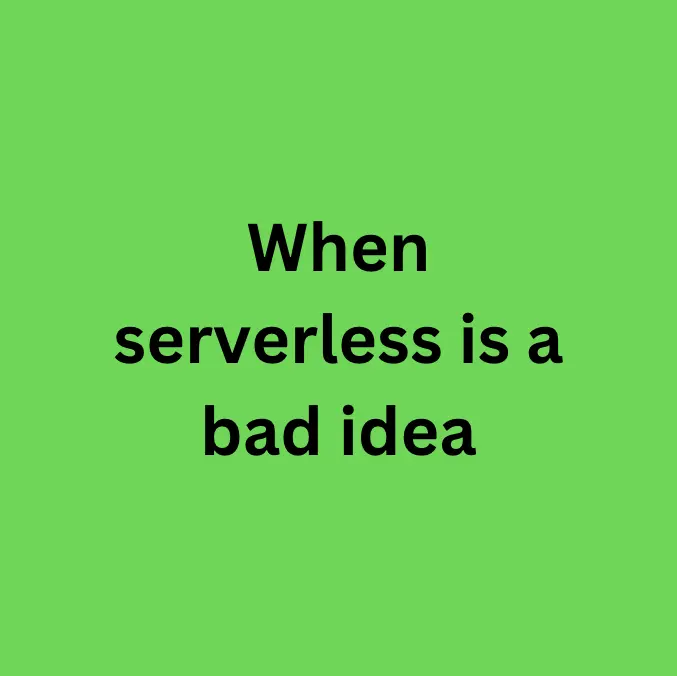· tutorials · 4 min read
When not to use serverless
Is Serverless Right for You? Consider performance, stateful apps, long tasks, high traffic, data processing, and security needs before deciding.

Serverless architecture can be a great solution for certain types of applications and workloads, but it may not be the best fit for every use case. Here are a few situations when serverless may not be the best choice:
- High-performance computing: Applications that require real-time processing or large amounts of data may not perform well in a serverless environment, as the overhead associated with spinning up and tearing down functions can add latency.
- Stateful applications: Applications that rely on maintaining a state across multiple requests may not be well-suited for serverless, as the stateless nature of functions can make it difficult to persist data between requests.
- Long-running tasks: Serverless functions are typically designed to run for a short period of time, so applications that need to run for extended periods may not be a good fit.
- High-traffic applications: Serverless can be expensive for high-traffic applications because of the cost of running many small functions.
- Large data processing: Serverless functions have limitations on their memory and CPU, which can make them less suitable for large-scale data processing.
- Security concerns: Serverless applications might have higher attack surface and harder to secure.
It’s important to evaluate your specific requirements and use case before deciding whether serverless is the right choice for your application.
So, what are the best use cases for serverless
Serverless architecture can be a good fit for a variety of use cases. Here are a few examples of when serverless can be a good choice:
- Event-driven workloads: Applications that respond to specific events, such as file uploads, user actions, or sensor data, can benefit from the ability of serverless functions to automatically trigger and scale based on those events.
- Microservices: Serverless functions are well-suited for building small, independent services that can be easily composed to create larger applications.
- Backend for mobile and web apps: Serverless can be used to build the backend for mobile and web apps, providing a cost-effective and scalable solution for handling user authentication, data storage, and business logic.
- Automation: Serverless can be used to automate repetitive tasks such as data processing, backups, and monitoring.
- Intermittent workloads: Applications that experience intermittent usage or bursts of traffic can benefit from the ability of serverless functions to automatically scale up and down based on demand.
- Cost efficiency: Serverless functions only charge for the time it’s running and the number of requests, this can be cost efficient for small or low traffic projects.
Major serverless providers
There are several major cloud providers that offer serverless computing services. Here are a few examples:
- AWS Lambda: Amazon Web Services (AWS) offers the Lambda service, which allows developers to run code without provisioning or managing servers.
- Azure Functions: Microsoft Azure offers the Azure Functions service, which allows developers to run event-driven code without managing infrastructure.
- Google Cloud Functions: Google Cloud Platform (GCP) offers Cloud Functions, which allows developers to run code in response to events and automatically scale as needed.
- IBM Cloud Functions: IBM Cloud offers Cloud Functions, which allows developers to create and run event-driven code without managing servers.
- Cloudflare Workers: Cloudflare offers Cloudflare Workers, which allows developers to write and deploy JavaScript code to the edge of Cloudflare’s global network.
- OpenFaaS: OpenFaaS is an open-source framework for building serverless functions, which can be deployed on any cloud or on-premises.
Netlify Functions
Netlify Functions is a serverless function hosting service provided by Netlify. It allows developers to deploy their serverless functions to the Netlify Edge network, which is a globally distributed edge network that is built on top of Cloudflare’s network. With Netlify Functions, developers can easily create and deploy backend logic and APIs for their web applications without needing to manage servers or infrastructure.
Netlify Functions is built on top of AWS Lambda and is fully compatible with the AWS Lambda runtime and event model, this means that you can use the same libraries and dependencies you would use when developing for AWS Lambda.
Netlify functions also integrates with the rest of the Netlify platform, which includes features such as continuous deployment, global CDN, and automatic HTTPS, making it easy for developers to build, test, and deploy their web applications.
Netlify functions allow developers to create functions using JavaScript, Go, and Python. It also allows developers to test and debug their functions locally before deploying them to the Netlify Edge network.